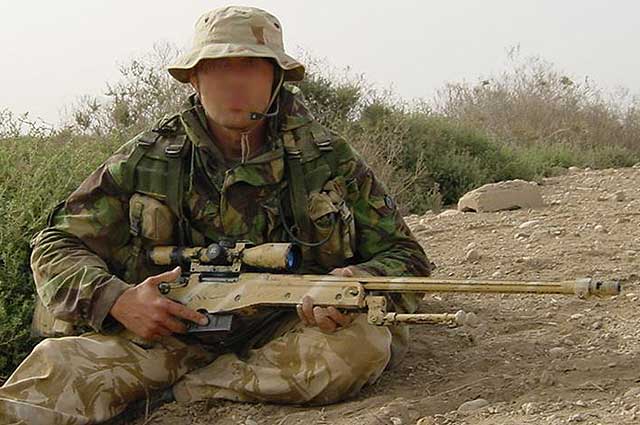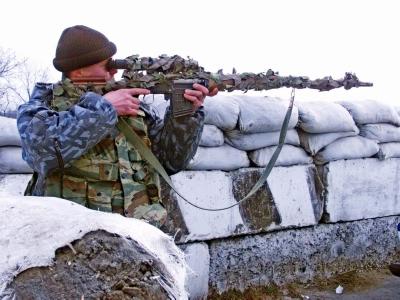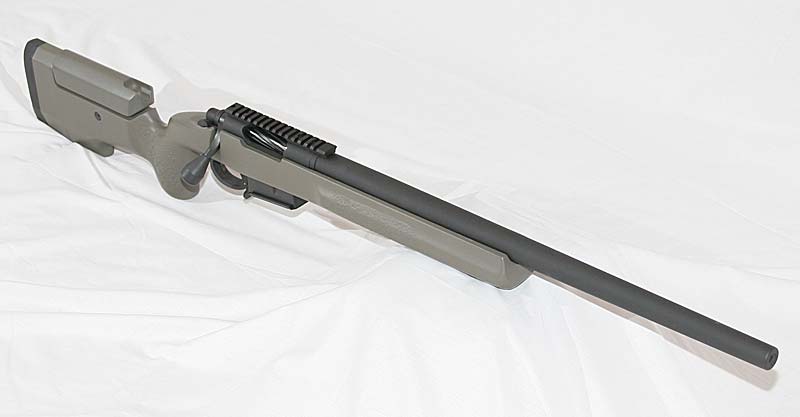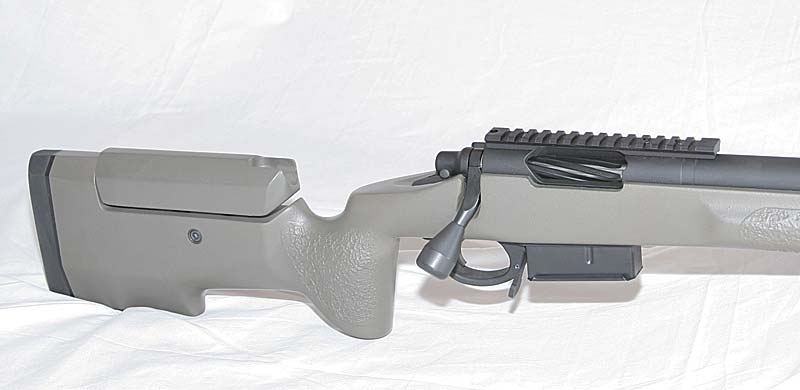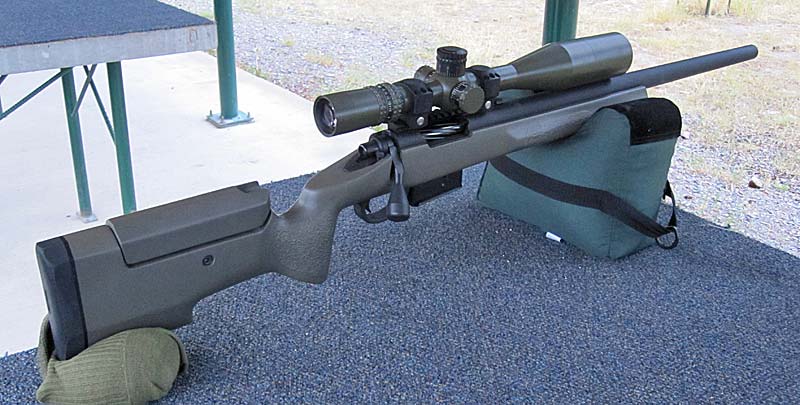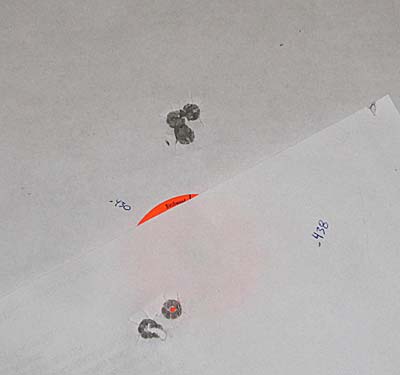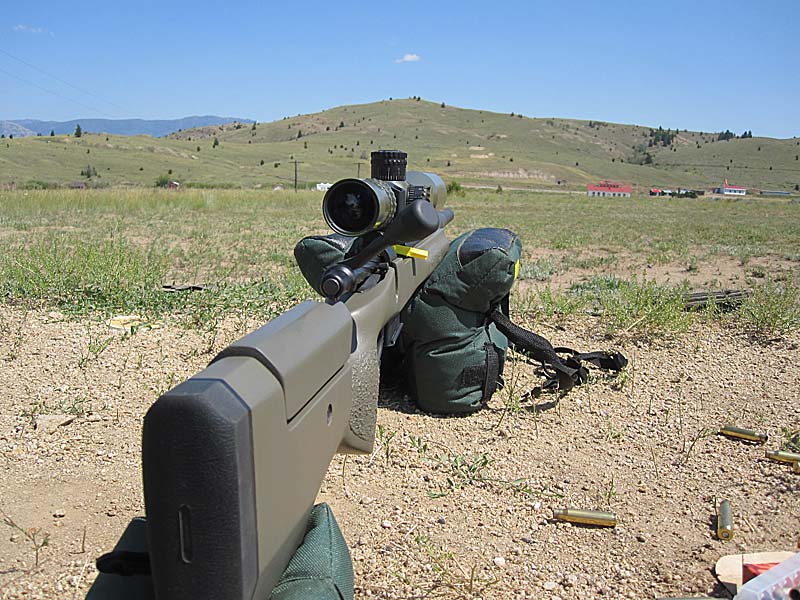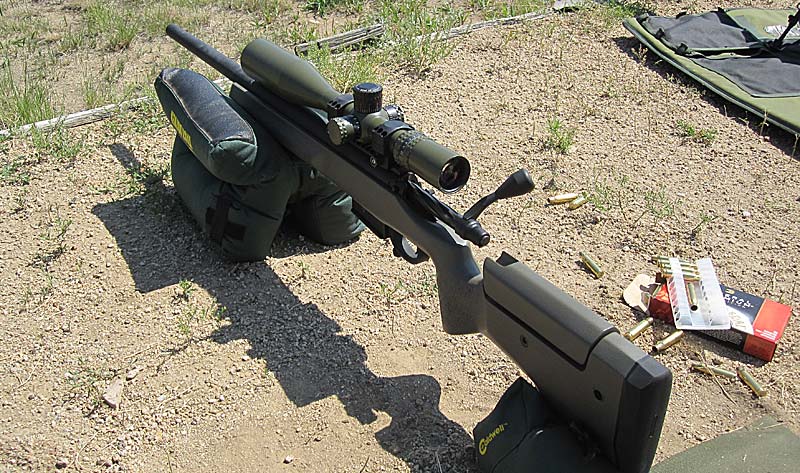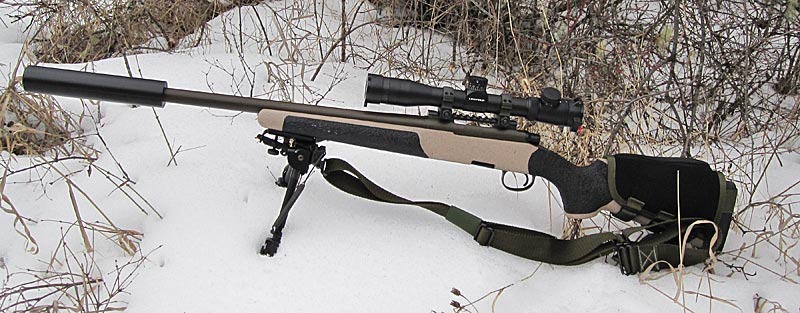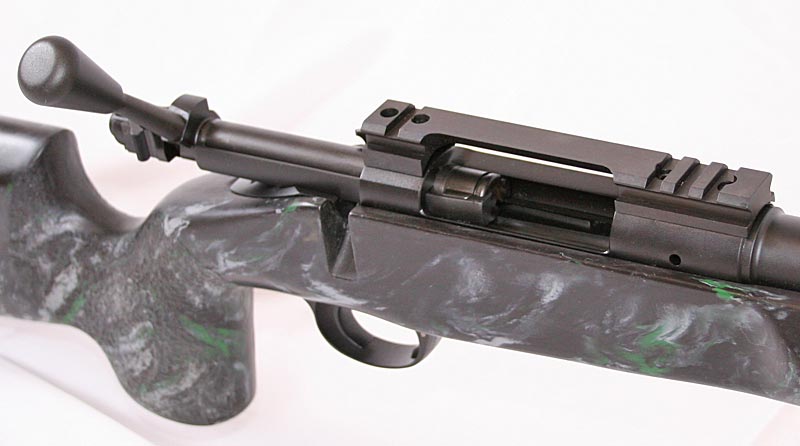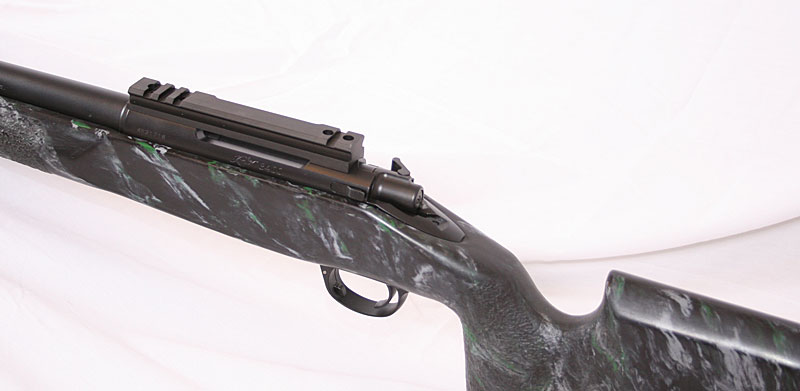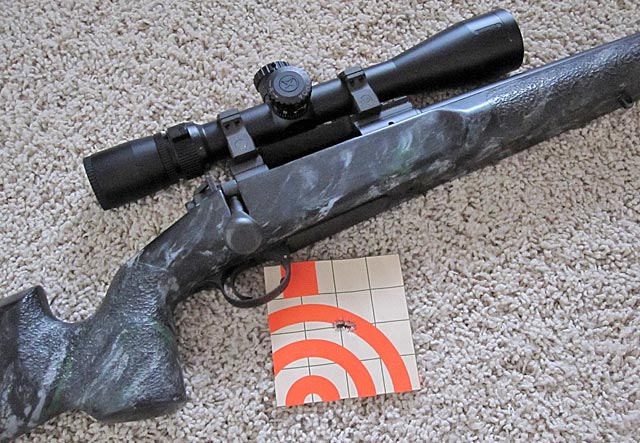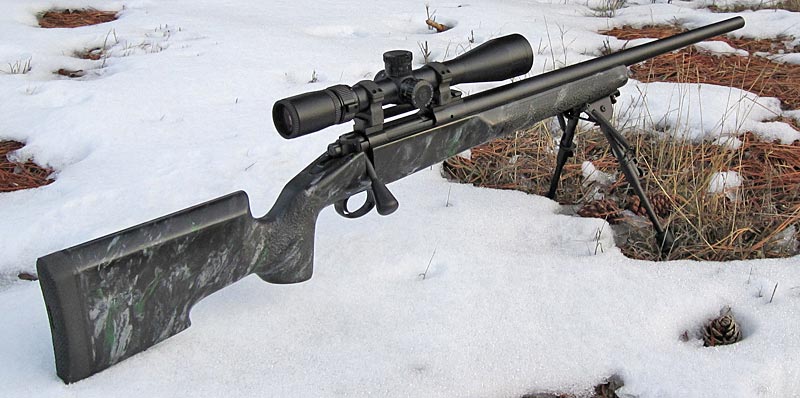The following article is a departure from the traditional rifle or equipment review that we normally conduct on Sniper Central. What I am specifically writing about this time is a conceptual idea that we had here over the past few years that I wanted to develop and see how it potentially could work and if it would pan out as desired. So this article is a written report on that idea, its development into an actual system and then a review of the finished product. It may become long winded as I cover the concepts and theories but I at least hope that it is interesting to the reader, so bear with me and follow along as I try to convey the idea and detail the project rifle.
Introduction
The concept of this rifle developed in my mind over the past several years as I watched the conflicts in the Middle East and as the sniping tactics evolved during those conflicts over the past several years. The one major area of change that evolved, more so in Iraq, was with the development of the urban battlefield as a major hot bed of combat operations and sniper involvement. It became such an integral part of the combat operations that it actually helped contribute to the adoption of a new Sniper Rifle for the US Army, the M110 Semi-Auto Sniper System (SASS) which is pictured below:

It turned out that while the M24 was an excellent sniper rifle and performed admirably, the sniper teams were getting more kills with their tricked M4's and M16's, especially when combined with the much better 77gr ammo (mk 262 Mod 1). This was also a time when the role of the Designated Marksman also became more defined and received more attention. The Designated Marksman (DM), or Squad Advanced Marksman (SAM), has been around for quite some time and originally developed from the concept that the former Soviet Union used with their SVD rifles and what they called snipers. They would attach a "sniper" to each rifle squad with and SVD and use them to extend the precision fire capability of the rifle squad. This concept was not the traditional use of a "sniper" but became the foundation of what the west called the Designated Marksman, someone who was trained and equipped with a longer range rifle, preferably with similar operation as a standard issued rifle, and was used to extend the precision rifle fire of the squad. This concept was "simmering" with both the USMC and US Army for a number of years before it really took hold in the early 21st century conflicts.
Now the common Designated Marksman Rifle (DMR) of choice seems to be the M16/M4 style rifle with upgraded parts including barrels, optics, and other devices to extend the range of the rifle and mostly still use the 5.56 NATO cartridge. The venerable M14 has also been used to build DMR rifles from and reports have been very good with these rifles. There have also been various other 7.62x51mm NATO rifles tested. Some rifle nomenclatures you may see would be the Mk12 Mod0 SPR, SAM-R, SPR, and others. The USAF has had a sniper program for a number of years as part of their security forces and they have also migrated their use of snipers from a true sniper to what they call an Advanced Designated Marksman using their already existing M24's.
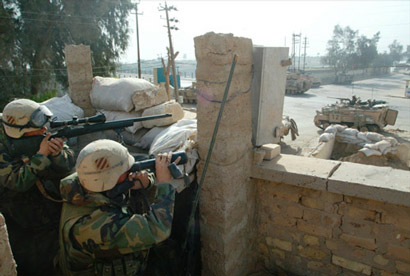
As I mentioned earlier, the role of the Sniper in the US Armed forces has gone through an evolution from the traditional two man sniper team to a large organic unit that typically ranges from 4-12 men and includes specialized teams and security elements. There are still traditional sniper operations that do happen, especially in other areas like Afghanistan where urban operations are not as common, and the teams are very flexible. In these areas, the traditional longer range sniper rifles have had a more prominent role and most have heard of some of the extreme range kills that have been made in that environment with 50 BMG, 338 Lapua, 300 Win Mag and 308 caliber rifles.
The US Army's adoption of the M110 in conjunction with their re-chambering of the existing M24's to 300 Win Mag shows their desire to evolve with the battlefield and bring more firepower with a semi-auto to the sniper team's disposal. The advantages of the semi-auto include very rapid follow-up shots, quick ammo reloading, quick ammo type changes, and more rounds between reloads. But with the M110 Semi-Auto there are also draw backs that include a larger profile rifle that is harder to conceal, semi-auto reliability (think lots of dirt and grime) and ejecting brass (target identifiers). I feel the M110 brings a lot of positive things to the table, but it does seem to take the sniper team closer toward the role of the Designated Marksman than a sniper. Granted, I do feel that the retaining of the M24 SWS in 300 Win Mag allows the team to retain their capability of a traditional sniper role, but what if we were to take this concept of the blended DM and Sniper and develop a specific rifle for that mission? Something that allows the sniper to have the capability to deliver extended precision rifle fire to the rifle squad but then also allow the sniper to deploy in a traditional sniper role and perform a stalk, engage a target with a single well aimed shot at long range, and extract safely, all the while providing valuable reconnaissance to the unit commander. Is this blended DM-Sniper the way I feel the role of the sniper should develop? No, it is not, I prefer the purely traditional role of the sniper with a separate designated marksmen for the squads, but I also realize that the US Army tends to gravitate their snipers to this more blended role as it tends to fit the mission of the Army a bit better and there is some merit to maximizing the men you already have. Also, it hopefully provides interesting reading for this article, so I figured it would be entertaining to see what I could come up with for a rifle to fill this blended DM/Sniper (DM/S) role. This article will cover further concepts of the DM/S as well as the rifle and equipment. To reiterate, this is not something I am advocating that the US, or any other military, should do, but it is an interesting intellectual exercise.
Defining the Role
As we discussed above, the role I am trying to fill is a blend of the Designated Marksman and the Traditional sniper and I am calling this role the DM/S. Before we develop the requirements for the rifle, we had to first fully understand and develop the concept of the DM/S in general and try to equip this soldier with the right equipment. Perhaps the best method to developing this role is to look at the two missions we are blending and then decide what this DM/S can, and cannot, do from each of these roles.
We will start with identifying what some of the primary responsibilities are for the Designated Marksman. The DM primarily is intended to be an integral part of the Infantry Squad, never being detached but instead being a fixed part of the squad. The standard infantry squad consists of two fire teams and a squad leader. Each fire team has a team leader with a M16 or M4, an Automatic Rifleman with a M249 SAW, a Grenadier with M16/M203, and a Rifleman with M16 or M4. So a total of nine men in each squad counting the two fire teams and the squad leader. The DM can replace any one of the eight positions in the two fire teams. One of the Riflemen is probably a good bet. Now each commander out there has the ability to organize the DM's as they see fit for their unit, so I am only describing one possible way to do it.
The Job of the DM is to function as a normal part of the squad, performing all of the normal and required duties of a squad Rifleman in an infantry company. The only real difference is with their equipment and training. They will tend to have a specialized rifle, typically a SPR style semi-auto rifle based on the M16 and firing 5.56 ammunition. The optics and more accurate rifle combined with some specialized training allow the DM to extend the range of engagements with precision fire up to 600 meters. This effectively doubles the range of the squad. Everything else with a DM essentially remains as a normal infantry squad member.
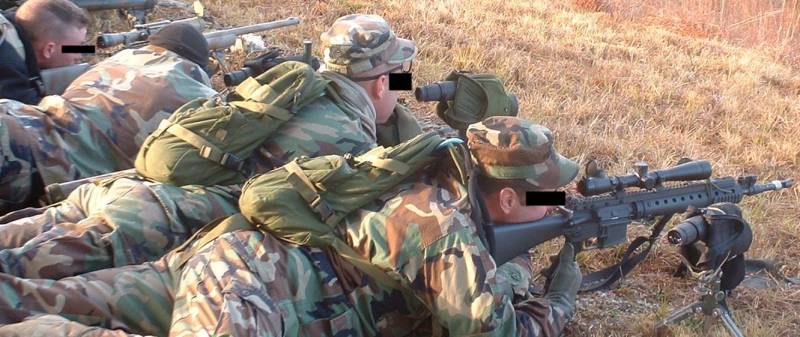
The sniper, on the other hand, is a very specialized team consisting of two, or sometimes more in today�s military, specially trained individuals that share shooter and spotting roles. Both have been school trained and are qualified as snipers. The sniper teams are usually a part of the Scout platoon which itself is attached to the HQ Company. The USMC has specially designated Surveillance and Target Acquisition (STA) platoons that are all scout/sniper trained. The US Army usually has a scout platoon that has a squad or so of qualified snipers, usually 3-5 two man teams. These snipers are essentially attached to the Battalion command and assigned out to the line Companies as needed or operate independently to perform their mission. The mechanized units of the US Army used to have one slotted sniper per mechanized company that was assigned to the HQ platoon and directly under the company commander to be used or assigned out as needed. This organization has changed in most Mech units in the 21st century and there is now usually is a sniper section in the Battalion HQ company, much like their light infantry brethren.
The mission of the sniper team is to engage high value targets and targets of opportunity in order to disrupt the enemy. Their secondary mission is to provide reconnaissance and surveillance for the Battalion and company commanders. This mission is much more involved than that of the DM and requires much more specialized fieldcraft training and the schools are much longer and more intense with a majority of the time spent on fieldcraft in addition to the long range marksmanship, where as the DM schools deal primarily with just marksmanship and weapons training. As you can see there is a large disparity in mission, training, organization and even equipment between the Sniper and the DM.
When considering the role of the DM/S the goal is to try and blend the role of a designated marksman with that of the dedicated sniper, so we would have a specialized team that is capable of effectively operating along side a dismounted rifle squad to extend the range of their precision rifle fire in combat but yet also have the training and capability of performing dedicated scout/sniper missions for the Commanding Officer (CO). I believe the training that is provided to snipers in the current US Military sniper schools would cover all of the fundamentals of this new DM/S position quite nicely so I see all DM/S soldiers as being sniper qualified (B4 in the US Army, 0317 in the USMC), though I do feel some additional training on the unit level would be required to help integrate and train the DM/S team on how to most effectively operate within the squad/platoon as the DM as well as train the unit itself on how to most effectively use the DM/S. I do not believe any additional training would need to be added to the current sniper schools. Some areas of emphasis that may need to be focuses on when training on the unit level for the DM portion of the DM/S may include:
- Full understanding of the strengths and weaknesses of the DM/S
- Coordinated fire between DM/S and squad and/or platoon
- Positioning and movement as part of a squad or platoon
- Using long range precision fire to direct and coordinate MG and other heavy weapons fire
- When to, and not to, utilize the specialize capability of the DM/S
- Reaction drills
- etc. etc.
One potential organization of the DM/S in the unit could be to have a semi-designated fire team as part of one of the squads. You could designate the four man fire team as a DM/S team and it could incorporate the DM/S as the fire team leader (E-5 slot), and the Rifleman slot within that fire team could be filled by the spotter. The Automatic rifleman, SAW gunner, and grenadier would remain as normal. This brings us to the point of the spotter. Who is it? Do they need to be trained like the DM/S? Do they have specialized equipment? These are all questions that would need to be answered within the unit organization. When the DM/S is operating as a DM, the requirement for a specialized soldier to act as the spotter is diminished and perhaps not required, but when performing the duties of a sniper, the importance of the spotter�s role is amplified. In the current outline that I am presenting, I would propose that the spotter be a standard rifleman that is not formally trained as a sniper but who is a competent soldier who can, or wants to be, trained in long range precision rifle fire or perhaps will replace one of the existing DM/Ss in time. This slot in the fire team could actually be the Rifleman or the Grenadier, but because of the bulk of the SAW, I would probably not recommend using the Automatic Rifleman to fill this role as DM/S assistant/spotter.
When looking at the makeup of the various units, a typical light infantry rifle platoon consists of three squads and the light infantry Company consists of three rifle platoons and a heavy weapons platoon. A mechanized infantry Company has a similar makeup consisting of three rifle platoons and with three rifle squads. So, if each squad had a designated marksman as an integral part of the squad it would mean a typical infantry company would have nine DM's. That is a lot of soldiers to train and a lot of specialized equipment to provide if we had the same amount of DM/Ss. If we were just trying to extend the range of the rifle squad, then this would probably be a good make up, but since we are defining a new role for this DM/S, which is a more specialized position and has duel capability, we will probably want to reduce this number to make training and equipping the DM/S more feasible. My proposed makeup would be to have one DM/S per rifle platoon making a total of three DM/S slots in the company, one available to each platoon leader to be tasked out as required, or all three available to the Company Commander to utilize as needed. It also gives a lot of reconnaissance and surveillance capability to the Company Commander and even the Platoon Leader.
If the means were available, the DM/S fire team could even be more specialized with the inclusion of an SPR style rifle for the Rifleman or even more specialized training being offered to the fire team for increased capability in reconnaissance and/or interdiction missions, but yet still retain the capability of a normal and functioning infantry fireteam. There could be some flexibility on a per unit basis, but the overall idea would be to have one fire team per platoon available to the Company Commander or Platoon Leader to be used to both extend the range of the platoon or squad in traditional combat as well as provide specialized scout/sniper capability as needed. As I contemplate this, it is similar to the old way snipers were organized in mechanized infantry units, but instead of only a single sniper in the old mechanized company, there would be three DM/S fire teams, each organic to a platoon.
Design Requirements for the Rifle
Now that we have defined how the DM/S would operate and integrate with an infantry unit, we can now discuss how we can best equip our newly designed DM/S soldier. When considering the new DM/S Weapon System and the particular role of the DM/S we need to keep in mind several aspects of the newly defined mission and address those specific needs for a weapon system.
Probably the first thing that needs to be considered is what caliber to use. Based off of the requirements for the DM/S I would put the maximum effective range needed for the system to be at least 800 meters which will allow for an effective extension of the squads precision fire range and also allow for sniper operations as well. When considering the cartridge to be used, we must consider the fairly large number of DM/S slots that would need to be filled, dictating that the chosen cartridge would need to be a military standard cartridge which pretty much left us with either 5.56x45mm NATO or 7.62x51mm NATO. Some might quickly dismiss the 5.56 as a poor choice for the desired capabilities of the DM/S weapon system, but with the advent of the MK262 Mod 0 and Mod 1 ammo with the 77gr bullets, the long range capability and lethality of the 5.56 has been greatly improved. But, the availability of this more specialized ammo for a normal, non Special Forces, infantry line unit is limited and the Mk262 Mod 1 still does not have the same long range capability of the 7.62x51 past about 600 meters where the wind can really play havoc on the 5.56, nor does it have the penetration capability and energy. The 7.62 does also have tracer, armor piercing and other specialized loads, including of course M118LR which is more widely distributed to infantry units than is the specialized Mk262 5.56 loads. For the DM/S rifle, the 7.62x51mm NATO is probably the better choice to accomplish the mission at hand, though the rifle should be capable of accurately firing both the M118LR as well as the standard 147gr FMJBT machine gun ammo known as M80 ball. I feel the system should include at least the capability of firing M80 because in a pinch, M118LR may not be available, but linked M80 typically is always available to an infantry unit for their M240 machine guns.
So just how accurate does this DM/S Weapon System need to shoot M118LR and M80 ball ammo? When considering long range accuracy and precision fire, accuracy is always of extreme importance so this was one of the primary concerns when considering the requirements of this weapon system. The more accurate you can make the rifle the better it is for the shooter and it will help cover-up some shooter error. Placing a requirement of .5 MOA accuracy on the rifle would be great, but because using the �not so accurate� machinegun ammo, this would be unreasonable. So a requirement of 1 MOA with M118LR, or other quality match ammo, and 1.5 MOA with M80 7.62x51 NATO ball ammo (147gr FMJBT) should work well. 1 MOA with sniper quality ammo should allow us to hit reliably at 800m with the system. Precision fire on 800M targets should accomplish all of the required demands on the DM/S soldier.
Because the DM/S is required to operate with the infantry units as a standard infantryman, the requirement for a rifle that is easily portable in both weight and size is needed. Running, jumping, diving, crawling, road marching, breaching and other common activities for the grunt on the ground are a lot different than a deliberate insertion or stalk that a sniper performs. The size and weight of the rifle can become a hindrance for these activities. Along those same lines, the legendary sniper Simo Hayha, from the Winter War (Finland WWII) with 542+ kills, actually stated that a sniper rifle should not weigh more than a M28/30 carbine which was about 8 pounds (3.6 kg). But the weight is not the only factor in play, the physical dimensions are also a consideration. The overall length of the rifle plays a major role in the suitability of a rifle when used in combat conditions. Again, lugging a long and heavy rifle around is fine when operating primarily as a sniper, but when breaching an obstacle or assaulting an objective, it can be a hindrance. I want something that is not much heavier or longer than a M-16A2. The overall length of the M16A2 is 39.63" (lets call is 40") and the weight is 7.78 lbs (how convenient, right about 8 lbs). So keeping the rifle about 40" long and 8 lbs should do it. 8 lbs is going to be tough with optics, but we will leave that as the requirement and see if we can meet it. A compact rifle does mean a shorter barrel, which will adversely effect the ballistics of the round, but we will deal with that as needed in the rifle development phase.
Another major component for this rifle will be whether it is a semi-auto design or a bolt action. Because of the requirement to operate with the line troops, the greater firepower offered by a semi-auto is perhaps preferred and if the operation is kept similar, or the same as, the M16 it would make for easier training of the DM/S. But conversely, the bolt action should not be ruled out, training continues with the M24 at the US Army Sniper School and with the M40 at the USMC Sniper School, where our DM/Ss would be trained and the operation of a Bolt Action is perhaps the simplest and most reliable of all the rifle actions to use and be trained on. The weight can be kept lighter with a bolt action and a higher level of accuracy is easier to achieve with a bolt action vs. a semi-auto, though ultimately the accuracy level ends up being about equal. I still personally prefer a bolt action for true sniper style operations because of the ability to control ejection and target identifiers, but I would prefer a Semi-auto for the DM role. For this requirement I would suggest that if a bolt action is chosen, the weight and size needs to be expressly controlled and the goal of 8 lbs has a much better chance of being achievable with a bolt action. The M110 with its 20" barrel and even without the suppressor comes in at 13+ pounds. For this exercise we are going through developing this rifle system, I will not put a hard limit that the rifle must be semi-auto or bolt action, we'll leave it open.
An optional way of approaching this weapon system would be to potentially use the rifle system in conjunction with a secondary rifle such as an M4. The DM/S concept is one of flexibility so having this option is a nice alternative that would allow the commander some added flexibility as needed. So to accommodate this, having a rifle that broke down in a level that did not compromise accuracy or repeatability would be a benefit, but I do not think this is a required feature. This would allow breaking the rifle system down into smaller components and storing it in a rucksack or other carrying device as needed and it would also allow the use of a standard combat rifle when needed with the DM/S rifle being stored in the rucksack.
With the added role of a DM as well as a Sniper rifle, our system has an increased need for being able to rapidly reload as well as a need for perhaps increased magazine capacity. If a semi-auto is chosen then this would not be an issue, as the M110 and other semi-autos will hold 20 rounds of 7.62x51 and the magazines are already detachable. Whether bolt action or semi-auto, I feel there is a requirement for rapid reloading with a detachable magazine with at least five rounds with an optional larger magazine of at least ten rounds as well. I specify the five rounds as we will need to be able to keep the rifle system suitable for sniper operations and having a flush or nearly flush magazine with little or nothing protruding from the bottom of the rifle is preferred for stalking and crawling.
On the modern battlefield the M110 has already proven the usefulness of a suppressor and with a compact system like we have in mind that is very flexible, I would think a detachable suppressor would be in high demand. I believe that threading a barrel on a rifle is so easy and cheap that there should be no reason not to include this requirement for this system. The Suppressor is not needed for most DM style operations but when operating as a sniper or even as a DM or Scout in urban environments it can come in handy as well. For weight purposes, a Titanium suppressor would be preferred, but not required.
In regards to the stock, it simply must be synthetic and durable. Because of the variety of sizes that soldiers are found in, an adjustable stock would be preferred, though I'm not sure if it would need to be required. The M-16 has never had an adjustable stock and it seems to work fine with all soldiers, the soldier just needs to adapt to the weapon system. Simplicity has a place on the battlefield as well. So I will not put a hard requirement that the stock must be adjustable, but it would be a nice feature.
That should just about cover the requirements of the rifle, but we need to discuss the optics requirement for the system. In order to properly extend the range of the DM/S, optics will be needed and I am a fan of using Bullet Drop Compensators (BDC) in combat conditions. Also, the optics on this particular system should have a large field of view to aide in combat awareness and close in engagements, but also have enough magnification to achieve our 800 meter goal. Using the rule of thumb of 1x for each 100 meters you want to be effective at, an 8x minimum magnification requirement will be needed. Because our DM/S's are sniper trained and the rifle system will conduct sniper operations as well, the scope needs to have some range finding capability; a mil reticle is preferred as that is the standard method. As I mentioned earlier, I believe in BDC's for combat use, especially on this system. While reticle BDC's can work, for this particular system, I would recommend a dial BDC that can be swapped out. Why? Because this particular system needs to be able to handle the M80 147gr machine gun ammo as well as the M118LR, and there is a significantly different ballistic chart for the M80 vs. the M118LR ammo. I would like to be able to have two separate BDC dials provided for the same scope to handle each kind of ammo in depending on what the DM/S has available. I would also like to see an illuminated reticle to aide in low light conditions or convoluted backgrounds. Yes, the illumination is another part that can fail in the field, but even if it does, it does not render the scope inoperable.
Of course, the scope needs to be mounted to a standard picatinny rail to allow the use of other optics if needed, and the rail itself, as well as the rings, should be very high quality and durable. Night vision capability could be useful on this system, though for the intended mission it is not a requirement. Perhaps even just a scope swap out on the rail would do the night vision trick if needed.
Well, that should about cover the requirements for this weapon system, so let us put together a complete list of what we have come up with for requirements.
Our list of requirements for the system includes: - 7.62x51 NATO (308 Win)
- 1 MOA with M118LR or commercial match ammo.
- 1.5 MOA with M80 NATO ball
- Overall length, less suppressor, 40"
- 8 lb weight, unloaded, no suppressor, with optics
- Break down capability for easy transportation (optional)
- Semi-auto or Bolt Action
- Detachable Box Magazine (DBM)
- Suppressor capable
- Durable, synthetic stock
- Adjustable Stock (optional)
- Scope with at least 8x magnification
- BDC located on the elevation dial
- Illuminated reticle
- Picatinny rail
- Night vision capable (optional)
With our new DM/S position defined as well as the requirements for the rifle system laid out, it must be time to start seeing what we can do to meet those requirements and how well the system works.
The Rifle Build
I will comment that while I was approaching this project as an attempt to build a rifle to fill the designed role, I was also building the rifle to be used by us here at Sniper Central and not purely for military use, and of course, I intended to keep the costs down as well. So some of the decisions made during the rifle build were made not purely to fit the requirements of the weapon system but also took into account other uses of the weapon outside of the designed DM/S role, as well as to utilize some existing parts and pieces I had here. With that being said, let us jump in and see how I went about building a system to fit the parameters of this newly defined DM/S.
Perhaps the single biggest decision facing this project was what action we were going to use and whether it was going to be a semi-auto or bolt action. When looking at the requirements I felt it would be easier to achieve more of the required elements by utilizing the simpler bolt action than it would be to try and get a semi-auto to fit the bill. This, obviously, is not to say that it could not be done using a semi-auto, but that it would be a bit easier to get closer to the weight and size requirements as well as a better chance at excellent accuracy as well, and in an effort to keep costs down I would be able to use some existing parts I had here. So I decided to go the route of the bolt action and not the semi-auto.
The use of a bolt action does limit the amount of available firepower and time of follow up shots when compared to a semi-auto, but it also has better reliability, durability, less weight and the shape is easier to utilize in sniper type operations. I felt that these positives put the bolt rifle on even ground with the semi-auto, but anything that could be done to aide in rapid follow up shots as well as additional firepower would be sought out during the design and build process. A large bolt knob is one such device that can help in speeding up cycling the bolt, especially when wearing gloves. Of course, polishing the rails and getting everything cycling very smooth is also a tremendous help in these regards.
Once the decision was made to go with a bolt action rifle it immediately turned to the Remington 700 for several primary reasons including availability and familiarity and also because of the very smooth operation a Remington 700 has when polished and trued. Having the action the same as the already in service M24 would be a good thing for training and cross training and the Remington does everything we need it to and there are many options for the parts and accessories we will need. I did consider some other actions as well, including some of the newer custom tactical actions from the likes of Surgeon, GAP, and others, but the Remington will get the job done and the familiarity with the M24 kept coming back, so a Remington 700 was chosen. I also opted for a short action, for this particular DM/S role I did not see a future need of having it chambered in a 300WM or other long action caliber and I wanted to keep the size and weight down on the rifle.
After the decision was made to go with a short action Remington 700 rifle I thought that I might be able to do something very simple and get is close to where we wanted to be quickly and cheaply. I happened to have a few HS Precision 700P take off stocks handy and I figured I could get a Remington 700 SPS Varmint in 308 Win with a heavy barrel and then simply cut the barrel to 16.5" and thread it for a suppressor and put it in the 700P stock with one of the HS precision detachable magazine floor plates, and then be done with it. The heavy barrel of the remington is not too heavy and is a good balance between rigidity and weight and this could be a quick solution that would meet most of the requirements. So we ordered up a SPS-Varmint in 308 and called up Tactical Operations to see if they would be willing to chop, thread and crown the barrel for me....
...and that is where things turned bad for the pocket book but good for the project. When talking to Mike at Tactical Operations about the project and the desired goals and requirements he indicated that it would be no problem to cut and thread the barrel for me, but why not just do a blue print job on the action while they were at it. Well, that seemed reasonable and should really insure that the accuracy requirements will be met as well as smooth up the action, so sure, why not. Then he mentioned that they had an older AWC stock there at the shop that just might fit the bill perfectly, primarily because it was a break down stock that separated just aft of the pistol grip. The stock was inletted for a Remington DBM floorplate, and while not as nice as some of the aftermarket units, it would fill the DBM requirement for the DM/S system. Oh, and did he mention he would give me a good deal on the stock and they would refinish it with paint and bed it all for me as well. Well, this all sounded really good and would actually fill a few more of the requirements of the system as well. But hey, since we were at it, why not finish all the metal work in the excellent Birdsong finish, Brown-T in this case, to insure it met all of the DoD requirements for durability and corrosion resistance.
All of a sudden I had a fairly custom rifle build happening on my simple conceptual idea for the rifle system, but the end result should be much better than my original idea. I actually still feel that my original simplified idea would work well for this project as well, and in fact Remington has recently announced a new SPS Tactical rifle with a short barrel that is already threaded. Just take one of those and drop it in the HS stock with the HS DBM and you have a simple to build system that should perform quite well and fit the bill fairly nicely for this project. That could be a fun little rifle not only for the DM/S project but for back packing, urban environments or other such adventures.
With all the parts and pieces sent off to Tactical Operations and the wait process begun, it was time to turn our attention to the optics and decide what to use there. While looking at the requirements for the project I was looking at four different scopes including a Zeiss Conquest 3-9x40mm with Z600 reticle, Nightforce NXS compact 2.5-10x32mm, Burris XTR 1.5-6x40mm and the Leupold Mk4 2.5-8x36mm.

Zeiss Conquest 3-9x40mm z600: The reason this scope was on the list was primarily for the BDC style z600 reticle and when I did the math I noticed that it worked out fairly well with the 147gr ammo. The reticle can be fairly accurate with different ammo types by changing the magnification of the scope and Zeiss has a tool on their web page to help you determine what those magnifications should be for the various different ammo loads. So the idea was that you could set the scope to a particular magnification depending on which ammo you were using, the M118LR or the M80 and then leave the scope on that power. This would have the same effect as having two different BDC knobs. But there were a few draw backs to this scope that included the lack of mil style range finding with the reticle, though it is setup for MOA ranging with 2 MOA hash marks. There was also the absence of an illuminated reticle which was also a draw back and finally, I thought the confusion of adjusting the magnification power to set the BDC to the bullet would cause problems and introduce the potential for error in combat conditions. These limitations ruled this scope out of contention, but I did purchase one to try out and had it mounted for a short while before I noticed the glass was cracked. It has since been replaced under warranty by Zeiss and it will be used on a different rifle with a review forthcoming.
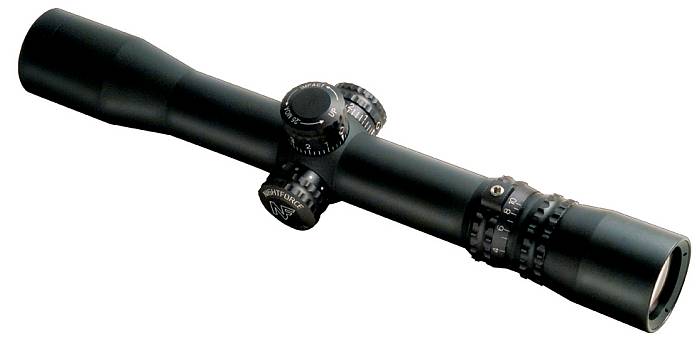
Nightforce NXS Compact 2.5-10x32mm: This scope was actually at the top of my list as they are compact, rugged, and have very good glass. There are many reticles available with the scope as well with illumination. The downside was that I could not find any BDC knobs available for this particular scope at the time I was looking to purchase. Kenton Industries makes many BDC knobs, and even makes them for the non compact NXS scopes, but they did not have, at the time I was purchasing the scope, the knobs for the compact versions. I considered the BDC to be one of the major requirements for this system and I could not bypass it, so this little compact NXS was ruled out. It is my understanding that Kenton is now making their BDC knobs for this model scope and if that were an option at the time of ordering I would have went with this scope combined with a mildot reticle.
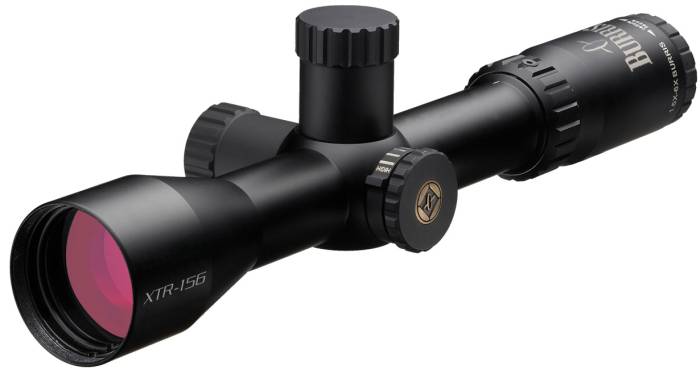
Burris XTR 1.5-6x42mm: This compact little scope has some interesting things going for it including some very large knobs and a different reticle. The reticle has BDC notches that are calibrated for the 7.62 round and could have worked, and it also has some mil hashes and the knobs can have a BDC engraved by Kenton Industries. The reticle is lit on the center as well. The only thing holding this one back was the lower 6x magnification. I was very close to purchasing this scope and even went to do it but they were out of stock, so I hesitated. I might pick one up for review and use on another rifle at some point.

Leupold Mk4 2.5-8x36mm MR/T: Leupold is one of the long term staples in the industry and some even say they are getting bypassed by some of the new scope makers. Their MK4 scope offerings are still very good and sometimes they have just the right features when no one else does. That was the case here. The scope had just the right amount of magnification on the top end, an illuminated mildot reticle, and was available with M2 BDC knobs from the factory. The scope is small and light and has good glass. The BDC knobs was set for standard 175gr match ammo and you can have either the Leupold Custom Shop or Kenton Industries make specially tuned BDC knobs for it in order to meet our requirement for BDC's for the M118LR as well as the M80 Ball ammo. The M2 knobs actually have .5 MOA clicks and I actually think they are a good thing for the scope and BDC as it reduces the amount of clicks per elevation changes and you can go well above 800m in a single revolution of the knob and yet the .5 MOA does have some level of precision as well. All in all, the scope had the features I needed available at the time of purchase and it made the final cut and was the chosen scope for the weapon system.
To mount the scope I chose a steel Nightforce base and steel Nightforce rings that I had here. For production, if it were to happen, I would probably opt for some of the Nightforce UL rings and bases or even one of their Unimounts in order to reduce weight even a bit more. Of course, there are some other very high quality rings and bases that would work as well, but we had the Nightforce rings and base on hand and opted to use them.
For the suppressor, we have a Tactical Operations 30 Cal suppressor that we use on several of our rifles here. There was no need to purchase a new suppressor as this one works quite well, though it is made out of steel and as such has a bit more weight than a titanium suppressor. The size of the can is just about right, nothing too large, and quite effective.
After a wait period for the work to be done, the rifle arrived here and the finished product looked very nice. We specified a tan color for the stock with black accents as well as dark brown metal work. Tan makes a good base color that can work just about anywhere. The stock is fairly short and compact and this goes well with the very short barrel. Part of the action tune-up from TacOps is a complete reworking of the bolt rails as well as smoothing and truing everything. This combined with the Birdsong finished makes for an extremely smooth operation of the rifle. The large TacOps bolt knob is also handy for manipulating the bolt with authority and speed. The Remington DBM is not the greatest, but it works and after some intial tweaking of the magazine it works very well and is easy to engage and disengage without any major problems yet. For sniper operations it is nice because it fits flush to the rifle, but is limited to only five rounds. The stock has the standard TacOps epoxy texture that provides great gripping surface in all weather as well as with gloves or without. There is only a single sling stud up front and for a production rifle I would probably opt for two sling studs up front or perhaps go to just a single one for the bipod and then flush cups for the sling. For this prototype, the single sling stud will work find. With the rifle here and looking good, It was now time for testing and then final assembly with the scope to see where we ended up at with a complete system.
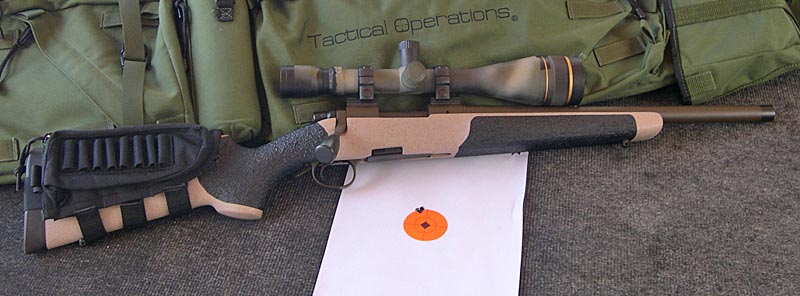
Test Results
Now that we had our DM/S weapon system coming together, I wanted to get an ultimate accuracy test with the rifle before mounting our duty optics with only a max magnification of 8x. So once we had the rifle back from Tactical Operations we mounted one of our test mule scopes, a Leupold VXIII LR/T 6.5-20x50mm that we use for accuracy tests with various rifles we review. We mounted the scope using some Leupold Mk4 bases and headed out to the range for some short range 100y groups just to have a baseline to go from in terms of ultimate accuracy with this rifle. For the test I decided to use the standard ammo we use for accuracy tests, the Federal Gold Medal Match 168gr, just to see what it would do. The M118LR ammo is good, but the GMM is what I use for all the rifle reviews just as our baseline and decided to try it out here as well. All of the groups were fired without the suppressor attached and as you can see below it did quite well.
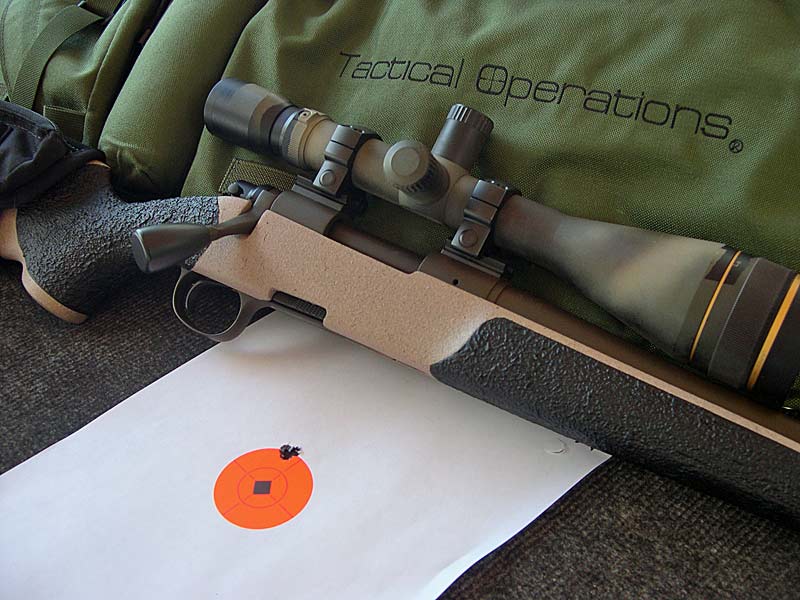
The rifle, even using the cut down factory Remington barrel instead of custom match barrel, shot exceptionally well. In fact it shot sub .25 MOA several times and the group above was the best of the day and measured .15" center to center. Apparently the accuracy requirement should not be a problem for this rifle. With the short range accuracy tests concluded it was indeed time to perform the final assembly and get the rifle together with the scope we planned to use. At that point it will be time to perform some longer range tests with the rifle all together as a complete system and in an environment where it was intended to be used in.
The rifle went together nicely with no major problems and the completed package looks and works well together. The smaller style scope fits the rifle nicely and to get the rifle in complete operational order, I fitted it with a TacOps cheek piece as well as a Swivel Harris Bipod and a TIS Quick Cuff Sling. I used an assortment of lighter colors to give it a lighter base color to work with in various locales. Combined with the suppressor the overall rifle is impressive. The scope is mounted using Nightforce rings and a Nightforce 20 MOA base.
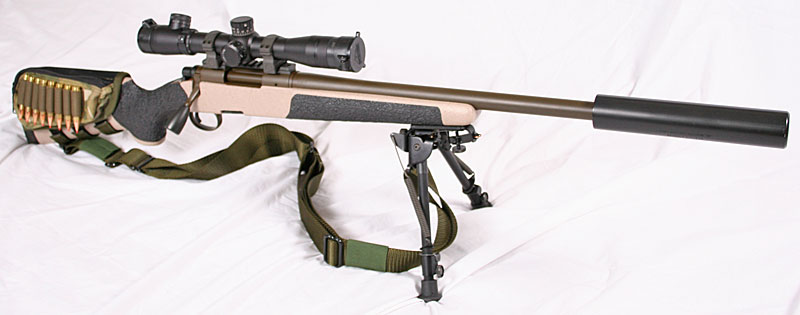
Now, I must admit to a bit of deviation at this point from the original requirements of the package. Because I planned to use this rifle for my own purposes here at Sniper Central, I elected to focus the rifle on one particular loading instead of having the BDC made for the military standard M80 147gr FMJBT ammo, I selected a more specialized loading that would provide better accuracy but still with a lighter and faster projectile. The load I elected to use was the 155gr AMAX load from HSM. It has an advertised velocity of 2875 fps and is loaded to the HSM match specs. Since this was the permanent load I wanted to use in this rifle system, I decided to measure the actual velocity of the load from the rifle. I knew that the shorter barrel was going to produce slower velocities so I just wanted to know exactly how fast it was so that the BDC could be made as close as possible to what the real world ballistics would be. If we were making this rifle to meet our DM/S specifications, I would follow this exact same procedure of measuring the velocity for the M118LR and the M80 147gr ball and then have all the BDC's printed to those results, I would most likely do this at Standard Atmospheric conditions. For this particular load, I measured just a tad over 2800 fps with our chrony 10' from the muzzle. I decided to use the 2800 fps number for our BDC with the published BC from Hornady of .435. I ordered the BDC knob from Kenton Industries and it arrived a few weeks later and the quality was very high, like normal. With the .5 MOA clicks and this particular load, the BDC goes from 100 to above 900 yards in a single rotation with the numbers marked above the normal moa marks on the dial.
The clicks on the Mk4 MR/T are audibly subdued yet with a very nice positive feel. The optics are good and the illuminated mildot reticle works well for targeting in poor light conditions. The MR/T has a fixed parallax which makes the operation simple, but does introduce the potential for parallax error at longer ranges, though this can be eliminated with good shooting technique using the same cheek weld every time. The scope has very good light gathering ability as well as a large field of view which are bonuses for combat use. Overall the operation of the rifle and scope are simple and straight forward. The detachable magazine detaches with a squeeze of the two "buttons" on the left and right of the magazine and after some initial tweaking with the floor plate assembly and magazines, it now works very well.
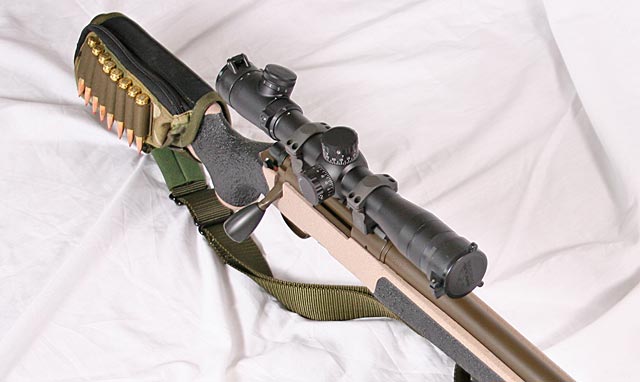
So it was time for tests that were more in line with how this rifle is going to be used. So I grabbed my sniper team mate and headed to one of the longer ranged areas we shoot at for some real world testing. Being that it was early spring in Montana, there was snow present so we brought along some appropriate attire for the testing and went to work. The target was a chest size plate of 20" tall and 18" wide up on a hillside and all shots were fired with the suppressor attached. Since we were testing the rifle as a system, I elected to use the known distance shooting points and test the rifle, scope, and BDC dials together for effective use at longer ranges on practical sized targets. I wanted to test the weapon system from 300 - 800 yards and as such we started at the closest and worked our way back in 100 yard increments. I am very pleased to report that we had first round hits at all ranges except for 500 yards where a gust of wind, and a bad shot from myself caused us to go off the right edge of target. The 2nd round, correctly adjusted and fired, was a center mass hit. The first round hit at 700 yards was actually fired left handed because our shooting position was very awkward from the side of a hill. My teammate also fired at 300-500 yards with equal success. Keep in mind this was all done using the 8x scope, which supports the fact that you do not need to have an overly high magnification scope to shoot long range, especially at the cost of light gathering and field of view that high magnification brings with it.
With the success we had from 300-800 yards, I decided to move back to 900 yards and see how it performed. I will admit that I did not get a first round hit on the target; we did get a hit with our 3rd round. The first two were very close, hitting just off the edge of the target. The rifle, ammo, scope and BDC knobs all performed very well together creating a DM/S rifle system that is very capable of making first round hits at up to 800 meters/yards, and perhaps further if the shooter is capable. I was very impressed with this little system. For references sake, I have done 100 yard groups with the 155gr AMAX load as well and have shot between .25-.5 MOA. Not as tight as the federal GMM 168gr, but still very accurate. We have since shot the rifle several other times at long ranges and the rifle continues to impress me and I am very pleased with the system as a whole and feel that is meets the performance requirements for the DM/S position.
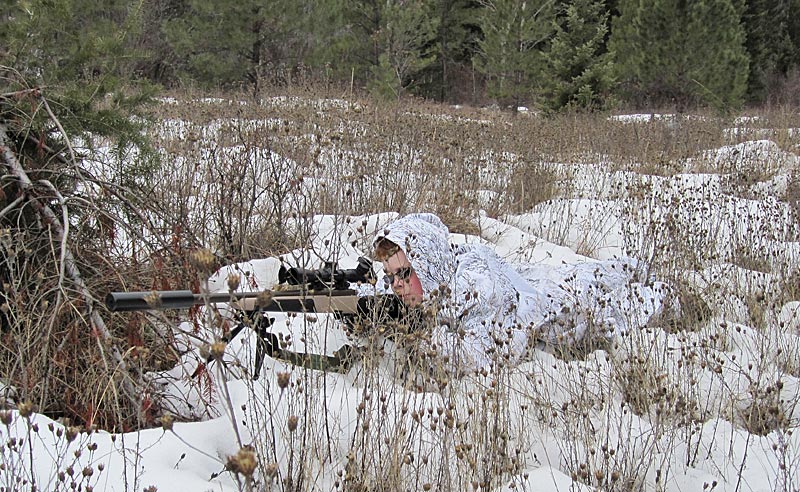
I also wanted to mention that I did test out the Leupold Anti Reflective Device (ARD) on the Mk4 scope as well. There are no sun shades currently available from Leupold for the 36mm Mk4 scopes to help prevent reflection from the glass optics. As such, I figured a rifle system intended for combat use may want to have some prevention of reflection. I ordered one of the Leupold ARD devices that attaches to the objective bell housing to address this issue. The ARD uses a honeycomb device to prevent sun glint from the glass, which it does a very good job at. Unfortunately, contrary to what the advertisements might indicate, there is a noticeable reduction in brightness in the scope. For combat, I would probably still use it more than I wouldn't, but I remove it most of the time when shooting so I can get the full brightness and clarity from the scope. I am not sure why Leupold does not offer a sunshade in 36mm, but the scope is setup to accept one and that is what I would prefer over the ARD for most situations.
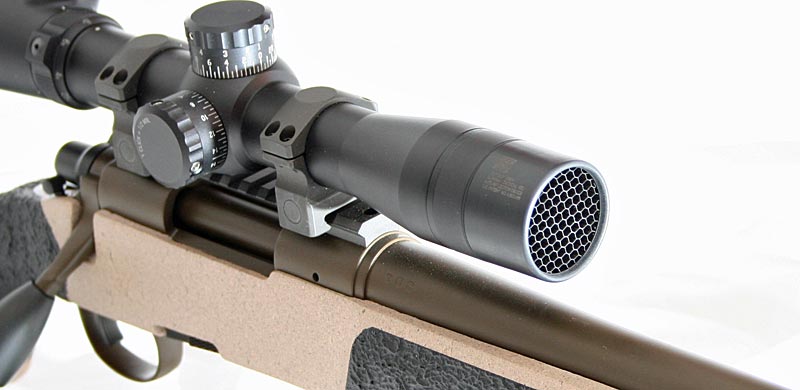
Mission Accomplished?
After testing the rifle and seeing that it certainly can perform very well, it was time to evaluate the system on a whole and determine if we had accomplished the mission we set out to do with this project. To determine that, I will look at each of the specification requirements that we came up with for this weapon system and see if we met them.
<Success> 7.62x51 NATO (308 Win) - Well, the rifle is chambered in 308, so that really was not too hard to accomplish.
<Success> 1 MOA with M118LR or commercial match ammo. - We were able to shoot sub .25 MOA groups with federal Gold Medal Match and sub .5 MOA groups with HSM 155gr Amax ammo that I tailored the weapons system for.
<Success> 1.5 MOA with M80 NATO ball - A few quick tests with some M80 ball indicated accuracy was around 1 MOA.
<Success> Overall length, less suppressor, 40" - The overall length without the suppressor is 36.5", with the suppressor attached it is 44"
<Failure> 8 lb weight, unloaded, no suppressor, with optics - Well, the rifle did end up being light, but anytime you have a heavy contour barrel for accuracy, it is going to get heavy. As you can see in the picture below, with the scope mounted, the weight was a few pounds over our 8 lb weight limitation.
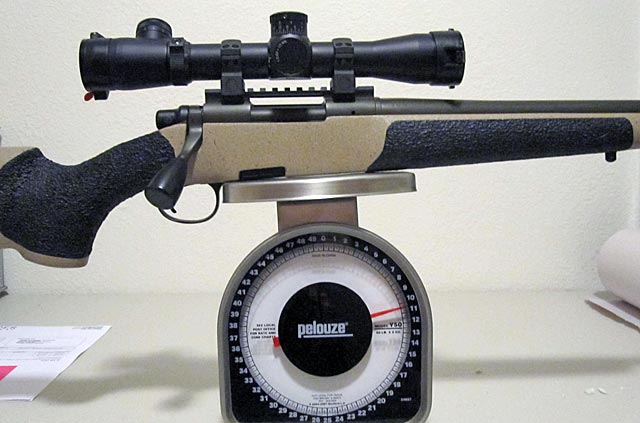
The rifle weighed in at 10.5 pounds empty and no suppressor. With the suppressor attached, ammo, bipod, sling and TacOps cheek pad, the rifle weighed 15.5 pounds. There are a few things we could do to potentially shave some weight from the rifle such as flutes in the barrel, UL alloy or Aluminum rings and bases, and potentially a different style stock. With all those changes, we could probably shave 1 - 1.5 pounds from the bare rifle, which would get us closer, but I do not think, with optics, that 8 pounds is really feasible. But it was a good goal to try. I think for the system, a 10 pound weight limit is probably more realistic and would not compromise the usefulness of the system as a whole.
<Success> Break down capability for easy transportation (optional) - While this was optional, we did accomplish it with the break down stock.
<Success> Semi-auto or Bolt Action - I elected to go with a bolt action and the Remington 700 is a familiar action and was used for our project here.
<Success> Detachable Box Magazine (DBM) - We used a standard Remington DBM system with 5 rounds. For a production version of the rifle I would probably opt for a HS Precision setup, or other alternative DBM floor plate. Why not use the excellent Badger Ordnance DMB system? Purely because of weight, they are large and add bulk, though robust and very good. Perhaps combining a HS Precision lighter weight stock and their floorplate some weight could be saved and the DBM requirement also met.
<Success> Suppressor capable - The barrel is threaded using standard thread dimensions and the rifle has been shot extensively with a suppressor attached. A thread protect was also provided with the rifle for use when the suppressor is not attached.
<Success> Durable, synthetic stock - AWC synthetic stock. Any of the high quality modern stocks could be used. I like the idea of an aluminum bedding block from HS Precision or potentially Bell & Carlson because of the durability vs. glass bedding. Yes, this rifle is glass bedded and glass/pillar bedding offers the ultimate in accuracy potential, but for combat use, I like durability and the aluminum bedding block holds up better especially when having to perform some maintenance in the field that may require separating the stock and action. Just something to be considered.
<Failure> Adjustable Stock (optional) - This was an optional, but desirable, feature to help fit many different sized soldiers. The AWC stock we were able to come up with did not have any adjustable bits on it. I am not totally sure how adjustable a combat rifle needs to be, but for accurate long range shooting, it can be important as well as for helping to properly align the shooters eye with the scope in a rapid manner.
<Success> Scope with at least 8x magnification - We used a Leupold Mk4 2.5-8x36mm MR/T with illuminated mildot reticle and M2 BDC dials. We had a specialized BDC dial made specifically calibrated to the ammo we intended to use. The same would be done for military ammo use if this rifle were to be submitted for adoption. The scope, rifle and BDC are capable of first round hits beyond 800 meters.
<Success> BDC located on the elevation dial - As indicated above we have a special BDC made for our specific round and for a duty rifle I would have one made for the M118LR as well as the M80 ball ammo. They take about 1 minute to change out, though you would want to keep track of zero shift with the change of ammo. The M80 is a lot faster and flatter shooting at closer ranges, but then the M118LR takes over at longer ranges and is ultimately more accurate. During my research into this project, I also discovered that there is a nice built in reticle BDC for the M80 ball. If you zero at 200 meters, you can keep the same point of aim at 100 and hit just a bit high, but you can also hold 1 mildot high at 300 meters, 2 mils at 400 meters and 3 mils at 500 meters and be close enough for kill shots. Actually, it is really quite accurate to 400 meters and at 500 it is close enough to be on target. This is a quick engagement method that will work very well for the DM/S when operating in the DM type role.
<Success> Illuminated reticle - The Leupold scope has the inside portion of the mildot reticle lit in red. Works well and has 11 different brightness levels.
<Success> Picatinny rail - Yep, no problem.
<Success> Night vision capable (optional) - This is a yes, but not as good as I would like. We met the criteria only because it has a picatinny rail which allows you to easily swap out the scope for a night vision scope. This is an optional requirement, but I think in today�s battlefield, this might move up to an actual requirement, similar to the M110. The magnification of this scope is also about ideal for night vision devices that mount in front of your day optics sight, such as the PVS-26. With that being said, if this were a prototype for production, I would look very hard at adding a forward mounted rail for just such a system, the downside is that it would add weight, something we are trying to avoid with the DM/S weapon system. Everything is a compromise....
As you can see from the above list of requirements, we were quite successful in my eyes. The big area we missed was with the weight, but as I mentioned, that requirement would probably need to be altered and we also have some areas where we could still shave a little bit of weight. Anything less than 10 pounds with optics mounted is considered very light in the sniping world, so I am happy with the results. The capability of the system is excellent providing all of the desired capability we were looking for in this system. No, we did not meet 100% of the requirements, but we did meet 14 of the 16 requirements and overall I think we have come up with a weapon system that would work great in the designated DM/S role.
Conclusion
Wow! Well, if you stuck with me throughout this entire article, then I'm impressed! I would have to say this has been a fantastic experiment and a fun project. It was especially engaging to go through the entire process of designing a role and creating a set of requirements and then try to meet those requirements. The rifle itself ended up being a gem and something we will continue to use here at SC for evaluations, write-ups and other activities for the site. I am grateful to all those that helped and contributed to the concept and the project. Will it go anywhere beyond this conceptual exercise? I don't know. I decided to make this article public domain instead of in the Members area to allow those people in a position to make decisions an opportunity to read about the concept and perhaps give them some additional ideas about organization and deployment possibilities. Of course, I am always happy to answer any questions.
I apologize if the article got a bit long winded, but hey, hopefully you, the readers, found it enjoyable and useful. Stay safe and shoot straight.
|

